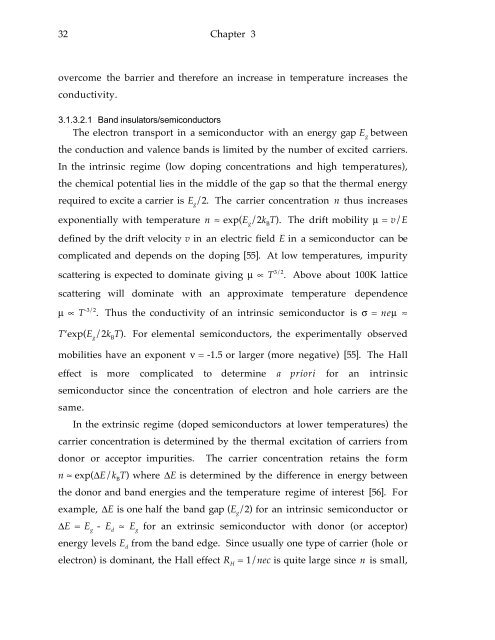MAGNETISM ELECTRON TRANSPORT MAGNETORESISTIVE LANTHANUM CALCIUM MANGANITE
MAGNETISM ELECTRON TRANSPORT MAGNETORESISTIVE LANTHANUM CALCIUM MANGANITE
MAGNETISM ELECTRON TRANSPORT MAGNETORESISTIVE LANTHANUM CALCIUM MANGANITE
You also want an ePaper? Increase the reach of your titles
YUMPU automatically turns print PDFs into web optimized ePapers that Google loves.
32 Chapter 3<br />
overcome the barrier and therefore an increase in temperature increases the<br />
conductivity.<br />
3.1.3.2.1 Band insulators/semiconductors<br />
The electron transport in a semiconductor with an energy gap E g between<br />
the conduction and valence bands is limited by the number of excited carriers.<br />
In the intrinsic regime (low doping concentrations and high temperatures),<br />
the chemical potential lies in the middle of the gap so that the thermal energy<br />
required to excite a carrier is E g /2. The carrier concentration n thus increases<br />
exponentially with temperature n ≈ exp(E g /2k B T). The drift mobility μ = v/E<br />
defined by the drift velocity v in an electric field E in a semiconductor can be<br />
complicated and depends on the doping [55]. At low temperatures, impurity<br />
scattering is expected to dominate giving μ ∝ T 3/2 . Above about 100K lattice<br />
scattering will dominate with an approximate temperature dependence<br />
μ ∝ T -3/2 . Thus the conductivity of an intrinsic semiconductor is σ = neμ ≈<br />
T ν exp(E g /2k B T). For elemental semiconductors, the experimentally observed<br />
mobilities have an exponent ν = -1.5 or larger (more negative) [55]. The Hall<br />
effect is more complicated to determine a priori for an intrinsic<br />
semiconductor since the concentration of electron and hole carriers are the<br />
same.<br />
In the extrinsic regime (doped semiconductors at lower temperatures) the<br />
carrier concentration is determined by the thermal excitation of carriers from<br />
donor or acceptor impurities. The carrier concentration retains the form<br />
n ≈ exp(ΔE/k B T) where ΔE is determined by the difference in energy between<br />
the donor and band energies and the temperature regime of interest [56]. For<br />
example, ΔE is one half the band gap (E g /2) for an intrinsic semiconductor or<br />
ΔE = E g - E d ≈ E g for an extrinsic semiconductor with donor (or acceptor)<br />
energy levels E d from the band edge. Since usually one type of carrier (hole or<br />
electron) is dominant, the Hall effect R H = 1/nec is quite large since n is small,
















